 |
DIN VDE 9400 - 9403 German socket and plug standards |
 |
DIN VDE 9400 - 9403 German socket and plug standards |
| The Verband Deutscher Elektrotechniker
(VDE) has laid down the characteristics of 6A and 10A - 250V,
2-pole, not earthed sockets and plugs. These devices were already in use for more than two
decades, but an official standard existed not until 1924. Pages 131 to 134 of the document about the DIN VDE 9400 series are shown below (DIN stands for Deutsches Institut für Normung). DIN VDE 9400 refers to not earthed 2-pole 6A-250V sockets; 9401 to matching 6A plugs; 9402 to 10A sockets and 9403 to 10A plugs. Images of 6A and 10A plugs have been added. Besides 6A and 10A sockets and plugs, also 1, 2, 4, 15, 25, 30 and 40A - 250V models have been designed. They differ in pin diameter and pin spacing. A summary is given at the bottom of the page. |
 |
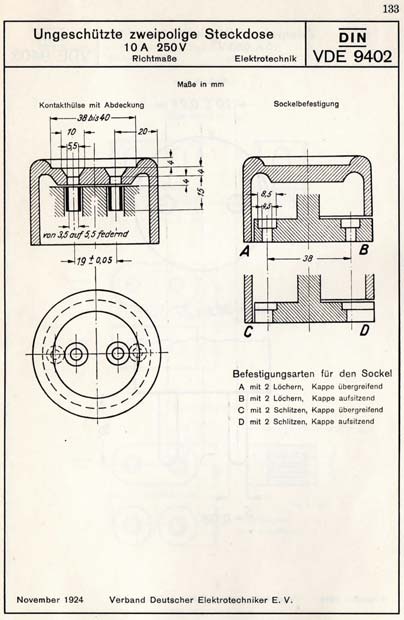 |
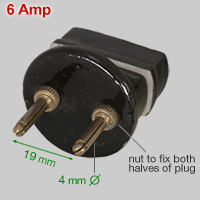 |
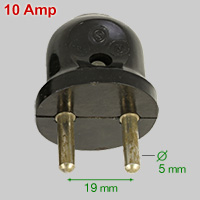 |
 |
 |
| Source: DIN Taschenbuch Nr. 8,
Beuth-Verlag, 1927 |
Note
on copyrights.
Extracts of the German Standards DIN VDE 9400 thru DIN VDE 9403
(Edition 1924) are reproduced for the notified and limited use with
permission 22.016 of the DIN German Institute of Standardization and
the VDE Association for Electrical, Electronic & Information
Technologies. For further reproductions or editions, separate
permission is necessary. Decisive for the usage of standards are the
editions with the latest date of issue. These most recent editions can
be ordered from VDE VERLAG GMBH, Bismarckstr. 33, 10625 Berlin,
Germany, www.vde-verlag.de
and the Beuth Verlag GmbH, 10772 Berlin,
Germany. |
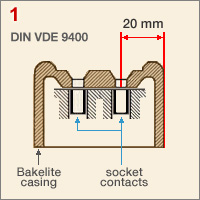 |
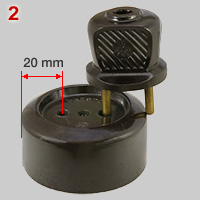 |
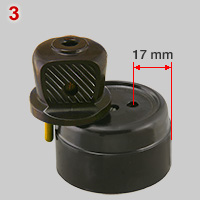 |
| 1 | Detail of DIN VDE 9400 standard (edited).
The standard stipulates that the distance from socket contact entry
hole (center) to casing outside has to be (at least) 20 mm. The
distance ensures that it is not possible to insert a single pin of a
DIN VDE 9401 plug. Both plug pins have to be inserted simultaneously.
Same rule applies also to DIN VDE 9402 sockets. |
| 2 | Socket that complies with DIN VDE 9400
standard. The sufficiently large socket casing prevents incorrect plug
insertion. Socket manufacturer: Presto, trademark used by Gebrüder Vedder, Fabrik elektrotechnischer Apparate in Schalksmühle (Westfalen, Germany). {RH} |
| 3 | Socket with a too small casing. Plug can
be inserted incorrectly. If the plug is attached to an appliance, there
is a risk that the unprotected pin is under tension. Socket manufacturer: Porzellanfabrik Theodor Pohl in Schatzlar (nowadays Žacléř in Bohemia, Czech Republic). The company was established in 1878 and started producing electro-technical devices for high and low voltage applications in the 1920s. Trademark Thepolit was used for the Bakelite components, among others the casing of socket no. 3. {RH} |
| 250V |
Plug
pin characteristics in relation to various maximum tolerated
currents* |
| 1A |
Pin diameter 3 mm; pin spacing 14 mm
(ca. ½ "). |
| 2-4A | No data available. Probably: pin diameter
2 or 3 mm; pin spacing 14 - 19 mm. See notes below. |
| 6A | Pin diameter 4 mm; pin spacing 19 mm (ca. ¾ "). |
| 10A | Commonly: pin diameter 5 mm; pin spacing
19 mm
(ca. ¾ "), but occasionally: 26 mm (ca. 1 ") |
| 15A | In the 1930s 15A plugs have been designed
with
7 mm pins and >1 " pin spacing. An upgraded version of 10A plugs had 5 mm pins and 19 mm pin spacing. See notes below. |
| 25A | Plugs have been designed with 7 mm pins
and >1 " pin spacing. |
| 30-40A | Pin diameter 8 mm; pin spacing 30 to 48
mm. Pin configurations of plugs for 25 - 40A were usually manufacturer
dependent. These plugs were rarely used in homes. |
| Notes * |
regarding use of plugs and sockets in Germany: • Less than 6A plugs were discontinued for domestic use after introduction of DIN VDE 9400-03. • From 1950 10A plugs and sockets became standard for newly build houses. • From 1960 earthed Schuko-type plugs and socket were compulsory for newly build houses. Initially they were rated at 10A DC / 15A AC, but nowadays rating is usually 16A (AC) - 250V. source: Bergmann Berlin, Sammelliste 1930. Data are collected by Reiner Hahn. |
| |
D i g i t a l M u s e u m o f | |
P l u g s a n d S o c k e t s | |